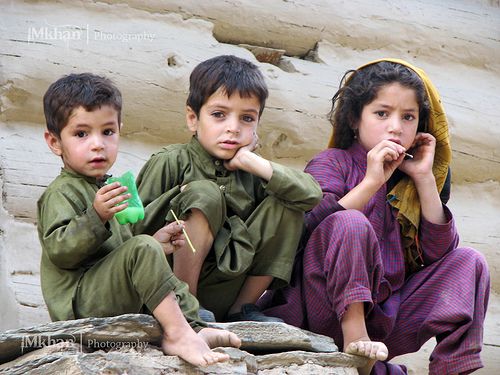
The deleterious armed conflict annexed with the politics of abomination has not only affected the developmental niches of the children in Kashmir, but has also led to intricate socio-cultural dimensions of this region. Every society is unique in its functioning, but conflict makes Kashmir more intriguing not for its quintessential landscapes but the impact of conflict on its denizens or shurree—the Kashmiri term for children. Childhood in Kashmir either gets skipped or adults do not come out of this social construct and remain embedded and entrapped even after passing through psychological definitions of adulthood. The questions that children witness in Kashmir have an epistemological base in the adult world because they skip their childhood pleasures and plays. They confront the questions of killings and conflict intricacies of the adult world. They witness the questions of survival and existence. Children construct meaning of the conflict through the processes of daily spectacles of violence, ongoing happenings, curfew and lockdowns in Kashmir. They witness and experience sudden crackdowns, cordon and search operations, and gun-battle and growing up in such a horrendous atmosphere leads the children to become hard, silent and full of emotional residue. The children do not only witness and experience this conflict at the personal or individual level, but they experience it at the family and school level as well. The parentchild relationship, teacherchild relationship and the total social fabric around them get influenced and destroyed. The children’s encounter with the forces, (including the army, paramilitary or police) hardly gives them any sense of belongingness or security. Firdous (name changed and ironically it means heaven) was sitting in his house when he was picked up by the police for a “routine” enquiry. He and his friend Faisal were allegedly seen in the “video shoot” of the stone pelters though all in the video had covered faces. The onus to prove absence from the stone pelting site was now upon these kids. These two along with the other five were randomly picked and were kept naked in a fourby-four “room” for two days and the intervening night. Many policemen came in and practised hurling their best abuses and hitting them with a red plastic pipe (this won’t leave marks!) when the parents made a hue and cry they all were released without much ado. The parents were perplexed about whether to celebrate the ‘freedom’ of their children or to complain about the illegal and extra-judicial captivities of their children. A survey carried out by Jammu and Kashmir Coalition of Civil Society in two districts of Kashmir found that from 1989- 2005, 292 children were killed because of various conflict-related incidents. It was also highlighted that 318 children were either killed or disappeared from 2005-2017 in the Kashmir valley. In 2018, around 31 children were killed in different incidents including an eight-month-old baby. In J&K, the NCRB also reported 470 crime incidents in 2019 followed by 606 in 2020, and then 845 in 2021 against children. The steady rise in crime incidents against children can be understood in the context of the conflict-crime nexus in Kashmir. Not only this, but the UN report on Children released in June 2022 also recorded the detention of 33 boys and killings of 34 children in Kashmir. These dismal statistics define the social space of Kashmiri Children: the space which is surrounded by uncertainty and fear. In 2020, 4-year-old Nihaan was hit by a bullet during cross-firing. In the same year, a 3-year-old kid sat on his grandfather’s dead body trying to wake him up but couldn’t. They were travelling in a car but got caught in cross-firing. Raffia also became a victim of decadesold conflict in 2022 when she got injured by a grenade blast, and many such incidents define the social space of Kashmiri children. The way Kashmiri children engage with the conflict intricacies needs a rational and balanced socio-political approach despite locking them up in the dungeon. The killings, curfew nights, crackdowns, and hartals have not only structured their psyche but also their engagement with the conflict. They construct, reconstruct and articulate meanings around their daily life events. The social events they witness make them active agents and thinking-making children. This is why C. Wright Mills finds the importance of the “Biography of an Individual in the milieu” and “history of a particular society” as determining factors in directing one’s future courses of action in a particular society. Children have constructed the language of conflict. The words like curfew, lockdown, and encounter have been constructed and structured in every child living in this region. We didn’t find a single child who is not acquainted with such terms. It depicts their social experiences embedded and entrapped in conflict. The children in Kashmir see socio-political events as normal and evolve their morals around them. They get their responses and understanding of the conflict from what Chitralekha Zutshi calls the “Kashmir narrative public” which means Kashmir narrative tradition and the world within which social events circulate and are consumed. The conflicts exist external to us and are the product of our historical heritage and social milieu. When a child is born, there is nothing genetically inscribed and imbibed about how he or she should behave in certain kinds of social situations, whether they would pelt stones or not or whether they will be national or anti-national beings but over time and the contexts of social happenings direct these children to act in specific ways and the contexts for peace are hardly visible in the valley. The responsibility is on all adult stakeholders to understand childrens’ worldviews and provide them with different experiences to establish peace even though they could not avert war in their own times.
Showkat Ahmad Mir is pursuing PhD in the Department of Education, Central University of Himachal Pradesh. Navneet Sharma teaches in the Department of Education, CUHP.















